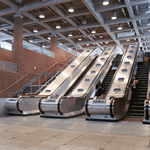Jubilee line facts
History

The Jubilee line is the Underground's newest line, but serves stations which originally opened over 100 years ago.
Inaugurated on 1st May 1979, the Jubilee line linked up the most recent sections of new tunnelling to open in central London - the four km (2½miles) of twin tunnels between Baker Street and Charing Cross - with the former Bakerloo Line branch between Baker Street and Stanmore.
The northern end of the line between Wembley Park and Stanmore was opened in 1932 as a branch of the then Metropolitan Railway.
The local services from Finchley Road to Wembley Park and the Stanmore branch became part of the Bakerloo Line in 1939, when the London Passenger Transport Board opened a new section of twin tube tunnels between Baker Street and Finchley Road with stations at St John's Wood and Swiss Cottage.
The Jubilee line is the Underground's newest line
The section south of Baker Street was opened in 1979 and terminated at Charing Cross.
Further extension to the Jubilee line was recommended in the East London Rail Study in 1989 with Royal Assent to the Bill obtained in March 1992.
Work started on the £3.5 billion project to extend the Jubilee line in December 1993. The extension runs from Green Park to Stratford and opened in three phases during 1999.
The extended Jubilee line was finally joined to the existing line on 20 November 1999, coinciding with the opening of Southwark station, with Westminster station the last to be opened on 22 December 1999.
Architecture on the Jubilee line
Architecture of the stations on the extension can only be described as spectacular
Architecture of the stations on the extension can only be described as spectacular. All have vast tracts of space and project architect Roland Paoletti CBE has employed world famous architects at the various stations resulting in a statement of importance not seen on the Underground since Charles Holden's designs of the 1930s.
Canary Wharf is arguably the largest, although during construction Westminster was the country's deepest and most complex excavation.
At London Bridge the new ticket hall imaginatively uses the brick arches below the Railtrack station.

Major architectural awards followed - the extension recently won the superlative accolade of Millennium Building of the Year by the Royal Fine Art Commission Trust.
In addition, four stations were specially commended - Westminster, Southwark, Canary Wharf and North Greenwich.
The Railway Industry Innovation Award for 2000 went to the entire Jubilee line extension. The Civic Trust's Urban Design Award was awarded to London Transport and again individual awards went to Stratford and Canary Wharf stations. In 1999 both Stratford and North Greenwich stations were awarded a Royal Institute of British Architects (RBIA) Civic and Community Award.
Stations on the rest of the line have a variety of styles ranging from late 1970s at Baker Street and south to Charing Cross, through late 1930s style at Kilburn and Dollis Hill, early 1930s Metropolitan suburban at Kingsbury, Canons Park and Stanmore, to 1920s Metropolitan urban at Willesden Green and 1880 Metropolitan rural at Neasden.
Jubilee line facts
Number of passengers on the Jubilee line
| Weekday | Saturday | Sunday | Annual (mil) |
|---|---|---|---|
| 405,878 | 271,739 | 182,480 | 127.584 |
The Jubilee line covers 36.2km (22.5 miles) and serves 27 stations between Stanmore and Stratford. The equivalent statistic for the new extended section is 16km (10 miles) of which 12.4 km (7.7 miles) is in tunnel and 3.5 km (2.3 miles) on the surface.

Jubilee line trains are known as the 1996 tube stock, manufactured by Alstom and entered into service between 1997-1999. This fleet consists of 59 trains, of which 47 trains, each of six cars, are required to operate the peak period service.
Jubilee Line trains are maintained in the main depot at Stratford Market. There are also sidings for stabling trains at Stanmore, and reversing sidings are provided at West Hampstead, Willesden Green and Wembley Park.
The then Prime Minister, the Rt. Hon John Major MP drove the first pile of the extension at a start-of-work ceremony at Canary Wharf on Wednesday 8th December 1993. The Jubilee line is also the only line on the Underground to connect with all other existing lines.
Jubilee line management
London Underground has recently established a Public Private Partnership (PPP) to secure stable, long term investment in the system. This follows the Government's announcement in March 1998 of its intention to divide London Underground into a publicly owned operating company and three privately-owned companies (Infracos) who will be contracted to maintain and enhance the existing network.
The PPP contract was signed with Tube Lines to upgrade, renew and maintain Jubilee line. Tube Line's contract also covers the maintenance of the Northern and Piccadilly lines.
In order to ease transition to the new PPP structure, the operational side of the Underground has been reorganised from individual lines to a new structure reflecting the proposed Infraco groupings. From September 1999, the Jubilee line has been grouped with the Northern and Piccadilly lines.
From November 2003, George McInulty will be responsible for delivering JNP (Jubilee, Northern and Piccadilly) train and station services to meet customers' requirements. The line's General Manager is Kevin Bootle.
Further information
If you wish to comment on the Jubilee line services, or would like to know more about the line, please contact us.
 Transport for London
Transport for London